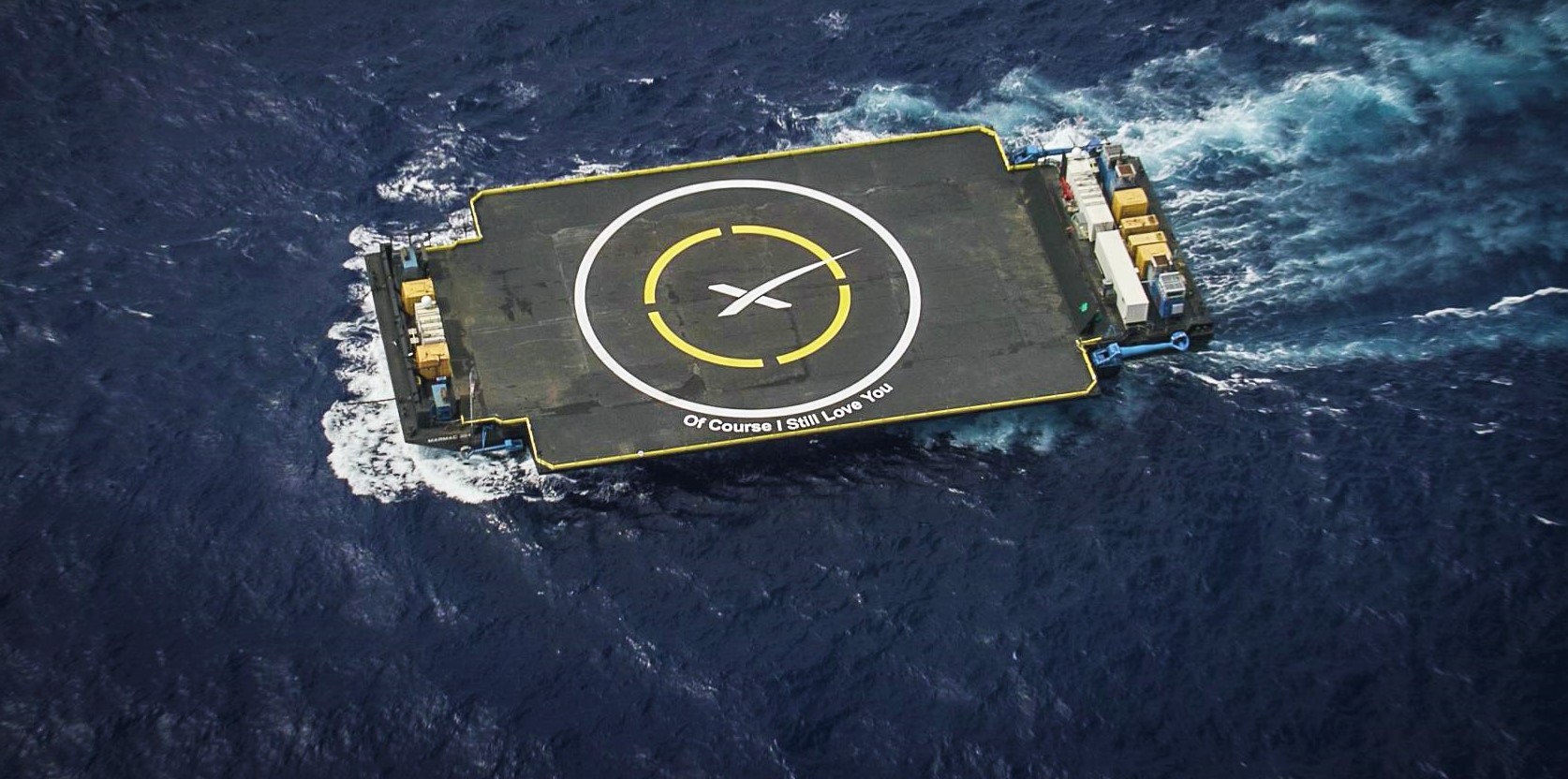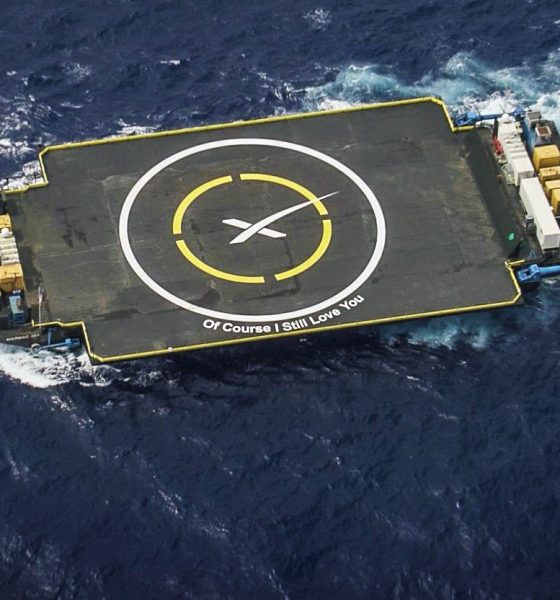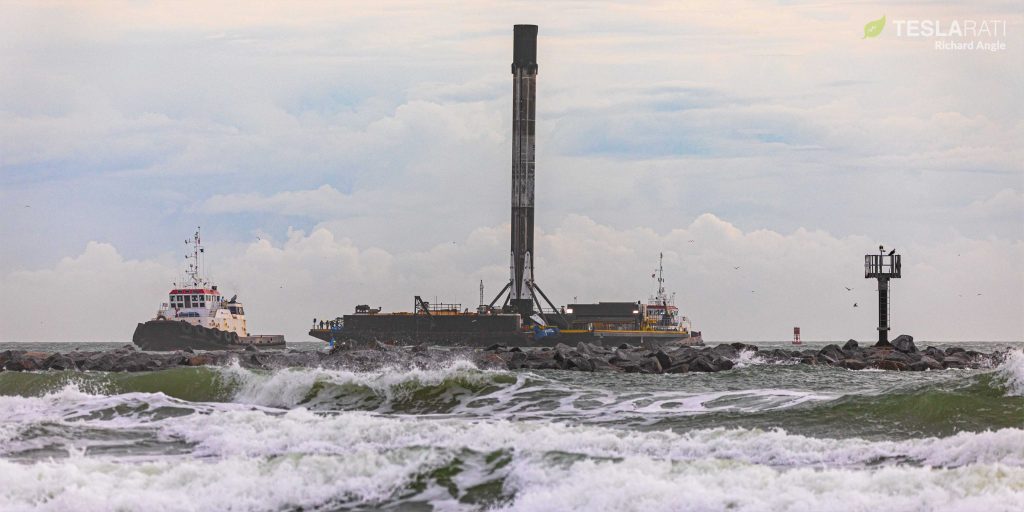

News
SpaceX drone ship dodges high seas en route to first rocket landing of 2020
SpaceX has delayed the first orbital launch of the new year by a handful of days to allow both Falcon 9 and the drone ship it’s scheduled to land on the opportunity to dodge bad weather on the Florida coast and out in the Atlantic Ocean.
Originally scheduled to launch no earlier than December 30th, SpaceX delayed its next mission – Starlink-2 – to January 3rd for unknown reasons. Weather on the new date was unfortunately forecast to be terrible at SpaceX’s LC-40 launch pad and had a 60% chance of scrubbing the mission. SpaceX must have been at least as concerned about conditions for drone ship Of Course I Still Love You (OCISLY) in the Atlantic Ocean, as the company ultimately skipped over a 90%-GO backup window on January 4th for the latest launch target – January 6th.
Historically, only a few Falcon launches have been delayed for booster recovery purposes, but it’s been apparent that – while incredibly sturdy – some of the tacked-on equipment installed on SpaceX’s drone ships (modified barges) can be easily damaged by high seas. Perhaps more importantly, high seas (and thus a pitching drone ship deck) can make booster landings much riskier. Bad luck could easily cause a booster to cut off its landing burn at exactly sea level but still be a dozen or more feet above the drone ship’s deck if it’s coincidentally in the trough of a big swell, potentially destroying or damaging the rocket.
Ultimately, on missions where SpaceX has nothing to lose by delaying the launch, the company now puts a successful booster recovery much higher on its list of priorities. As recently as March 2018, SpaceX intentionally expended a new Falcon 9 booster because ocean conditions would have been extremely risky to OCISLY and crew and the company (or customer) had no interest in delaying the launch further to wait for calmer seas.
By all appearances, that is – for the most part – no longer the case. SpaceX would likely expend a rocket for a few days of schedule for high-priority customers like the USAF and especially NASA, where even a few days of delays could trigger several years of delays to quite literally wait for the planets to realign. It has and will continue to require a significant culture shift in the market for launch but SpaceX is clearly changing those norms and expectations bit by bit, to the point that the company was recently willing to delay Cargo Dragon launches for NASA to ensure that the mission’s Falcon 9 booster the best possible chance of recovery.
For an internal Starlink launch, delaying the mission to prevent drone ship damage and ensure Falcon 9 recovery is thus an absolute no-brainer. Starlink-2 is also partially unique because it will mark the second time a Falcon 9 booster launches for the fourth time, following on the footsteps of B1048 after it became the first booster to launch four times during SpaceX’s November 2019 Starlink-1 mission.
B1048 thus became SpaceX’s lone pathfinder for Falcon 9 booster reusability, hopefully providing excellent insight and some unequivocal physical data to determine the rocket’s health and readiness for a 5th launch. Still, even though the sample sizes available to even the most prolific orbital launch vehicles would make any statistician cringe, it’s safe to say that two data points are better than one, and B1049 – scheduled to launch for the fourth time on Starlink-2 – would thus be quite valuable to SpaceX’s recovery engineers and technicians.

Only one additional Falcon 9 booster – B1056 – has already flown three missions, meaning that SpaceX will – at best – likely have to suffice with three data points (B1048, B1049, B1056) before moving onto the next reusability milestone – launching the same booster five times. Ultimately, every time SpaceX pushes that envelope and demonstrates that Falcon boosters can be definitively reused 3 or 4 or 5 times, the company multiplies the number of launches its fleet of booster can perform by a factor of two.
For, say, the eight flightworthy boosters in SpaceX’s existing fleet, proving that a 4th reuse is possible will ultimately allow the company to squeeze an additional seven launches from existing hardware with almost zero capital investment. For now, the fourth flight of Falcon 9 boosters will remain cutting edge, but with more than three-dozen launches planned in 2020, it’s all but guaranteed that SpaceX will push the envelope of reusability like never before in the coming months.
Check out Teslarati’s Marketplace! We offer Tesla accessories, including for the Tesla Cybertruck and Tesla Model 3.

News
Tesla (TSLA) receives “Buy” rating and $551 PT from Canaccord Genuity
He also maintained a “Buy” rating for TSLA stock over the company’s improving long-term outlook, which is driven by autonomy and robotics.

Canaccord Genuity analyst George Gianarikas raised his Tesla (NASDAQ:TSLA) price target from $482 to $551. He also maintained a “Buy” rating for TSLA stock over the company’s improving long-term outlook, which is driven by autonomy and robotics.
The analyst’s updated note
Gianarikas lowered his 4Q25 delivery estimates but pointed to several positive factors in the Tesla story. He noted that EV adoption in emerging markets is gaining pace, and progress in FSD and the Robotaxi rollout in 2026 represent major upside drivers. Further progress in the Optimus program next year could also add more momentum for the electric vehicle maker.
“Overall, yes, 4Q25 delivery expectations are being revised lower. However, the reset in the US EV market is laying the groundwork for a more durable and attractive long-term demand environment.
“At the same time, EV penetration in emerging markets is accelerating, reinforcing Tesla’s potential multi‑year growth runway beyond the US. Global progress in FSD and the anticipated rollout of a larger robotaxi fleet in 2026 are increasingly important components of the Tesla equity story and could provide sentiment tailwinds,” the analyst wrote.
Tesla’s busy 2026
The upcoming year would be a busy one for Tesla, considering the company’s plans and targets. The autonomous two-seat Cybercab has been confirmed to start production sometime in Q2 2026, as per Elon Musk during the 2025 Annual Shareholder Meeting.
Apart from this, Tesla is also expected to unveil the next-generation Roadster on April 1, 2026. Tesla is also expected to start high-volume production of the Tesla Semi in Nevada next year.
Apart from vehicle launches, Tesla has expressed its intentions to significantly ramp the rollout of FSD to several regions worldwide, such as Europe. Plans are also underway to launch more Robotaxi networks in several more key areas across the United States.
News
Waymo sues Santa Monica over order to halt overnight charging sessions
In its complaint, Waymo argued that its self-driving cars’ operations do not constitute a public nuisance, and compliance with the city’s order would cause the company irreparable harm.

Waymo has filed a lawsuit against the City of Santa Monica in Los Angeles County Superior Court, seeking to block an order that requires the company to cease overnight charging at two facilities.
In its complaint, Waymo argued that its self-driving cars’ operations do not constitute a public nuisance, and compliance with the city’s order would cause the company irreparable harm.
Nuisance claims
As noted in a report from the Los Angeles Times, Waymo’s two charging sites at Euclid Street and Broadway have operated for about a year, supporting the company’s growing fleet with round-the-clock activity. Unfortunately, this has also resulted in residents in the area reportedly being unable to sleep due to incessant beeping from self-driving taxis that are moving in and out of the charging stations around the clock.
Frustrated residents have protested against the Waymos by blocking the vehicles’ paths, placing cones, and “stacking” cars to create backups. This has also resulted in multiple calls to the police.
Last month, the city issued an order to Waymo and its charging partner, Voltera, to cease overnight operations at the charging locations, stating that the self-driving vehicles’ activities at night were a public nuisance. A December 15 meeting yielded no agreement on mitigations like software rerouting. Waymo proposed changes, but the city reportedly insisted that nothing would satisfy the irate residents.
“We are disappointed that the City has chosen an adversarial path over a collaborative one. The City’s position has been to insist that no actions taken or proposed by Waymo would satisfy the complaining neighbors and therefore must be deemed insufficient,” a Waymo spokesperson stated.
Waymo pushes back
In its legal complaint, Waymo stated that its “activities at the Broadway Facilities do not constitute a public nuisance.” The company also noted that it “faces imminent and irreparable harm to its operations, employees, and customers” from the city’s order. The suit also stated that the city was fully aware that the Voltera charging sites would be operating around the clock to support Waymo’s self-driving taxis.
The company highlighted over one million trips in Santa Monica since launch, with more than 50,000 rides starting or ending there in November alone. Waymo also criticized the city for adopting a contentious strategy against businesses.
“The City of Santa Monica’s recent actions are inconsistent with its stated goal of attracting investment. At a time when the City faces a serious fiscal crisis, officials are choosing to obstruct properly permitted investment rather than fostering a ‘ready for business’ environment,” Waymo stated.
News
Tesla FSD v14.2.2 is getting rave reviews from drivers
So far, early testers have reported buttery-smooth drives with confident performance, even at night or on twisty roads.

Tesla Full Self-Driving (Supervised) v14.2.2 is receiving positive reviews from owners, with several drivers praising the build’s lack of hesitation during lane changes and its smoother decision-making, among others.
The update, which started rolling out on Monday, also adds features like dynamic arrival pin adjustment. So far, early testers have reported buttery-smooth drives with confident performance, even at night or on twisty roads.
Owners highlight major improvements
Longtime Tesla owner and FSD user @BLKMDL3 shared a detailed 10-hour impression of FSD v14.2.2, noting that the system exhibited “zero lane change hesitation” and “extremely refined” lane choices. He praised Mad Max mode’s performance, stellar parking in locations including ticket dispensers, and impressive canyon runs even in dark conditions.
Fellow FSD user Dan Burkland reported an hour of FSD v14.2.2’s nighttime driving with “zero hesitations” and “buttery smooth” confidence reminiscent of Robotaxi rides in areas such as Austin, Texas. Veteran FSD user Whole Mars Catalog also demonstrated voice navigation via Grok, while Tesla owner Devin Olsen completed a nearly two-hour drive with FSD v14.2.2 in heavy traffic and rain with strong performance.
Closer to unsupervised
FSD has been receiving rave reviews, even from Tesla’s competitors. Xpeng CEO He Xiaopeng, for one, offered fresh praise for FSD v14.2 after visiting Silicon Valley. Following extended test drives of Tesla vehicles running the latest FSD software, He stated that the system has made major strides, reinforcing his view that Tesla’s approach to autonomy is indeed the proper path towards autonomy.
According to He, Tesla’s FSD has evolved from a smooth Level 2 advanced driver assistance system into what he described as a “near-Level 4” experience in terms of capabilities. While acknowledging that areas of improvement are still present, the Xpeng CEO stated that FSD’s current iteration significantly surpasses last year’s capabilities. He also reiterated his belief that Tesla’s strategy of using the same autonomous software and hardware architecture across private vehicles and robotaxis is the right long-term approach, as it would allow users to bypass intermediate autonomy stages and move closer to Level 4 functionality.








